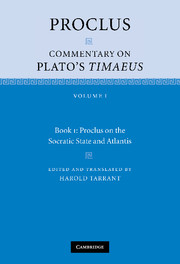General introduction to the Commentary
Published online by Cambridge University Press: 15 January 2010
Summary
The importance of the timaeus and its commentary tradition
Proclus' Commentary on the Timaeus is arguably the most important text of ancient Neoplatonism. The Timaeus itself has proved to be the most important of all Plato's works from a historical perspective, for it remained a key text from the death of Plato, through Hellenistic philosophy, Philo of Alexandria, Middle Platonism, and the Christian fathers, down to the Neoplatonists, and well beyond. The fact that in the past century or so it has been effectively challenged by the Republic for the title of ‘Plato's greatest work’ means little in the 2500-year history of Platonism. The Timaeus was acknowledged as one of the two supreme texts of the Neoplatonist curriculum. The other was the Parmenides, which was of similar importance to many Neoplatonists, but less widely acknowledged as central to a Platonic education.
The commentary itself was usually the major vehicle of Neoplatonist teaching, even though much of what survives on Plato, unlike Aristotle, is not in this form. Interpretation of authoritative texts, including many of those of Plato, was a central part of a Neoplatonist's work. The commentary arose directly out of the reading of texts in the schools of philosophy, though some commentaries went on being used by subsequent generations, for which reason Proclus would have been conscious that he was not writing an ephemeral work, but one that could be used in other contexts.
- Type
- Chapter
- Information
- Proclus: Commentary on Plato's Timaeus , pp. 1 - 20Publisher: Cambridge University PressPrint publication year: 2007
- 3
- Cited by

